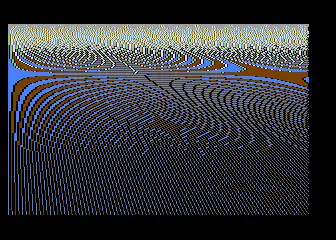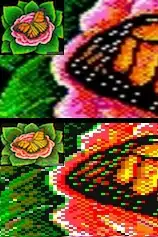Composite artifact colors
Composite artifact colors is a designation commonly used to address several graphic modes of some 1970s and 1980s home computers. With some machines, when connected to an NTSC TV or monitor over composite video outputs, the video signal encoding allowed for extra colors to be displayed, by manipulating the pixel position on screen, not being limited by each machine's hardware color palette (though, on modern TVs it might not work as well).




This mode was used mainly for games, since it limited the display's horizontal resolution more than normal. It was mostly used on the IBM PC (with CGA graphics),[1] TRS-80 Color Computer[2] and Apple II[3] computers, but also possible on Atari 8-bit.[3]
The limitations of composite video regarding horizontal resolution were also exploited on other systems. Adjacent pixel values got averaged horizontally, producing solid colors or generating transparency effects.
On PAL displays (or NTSC 4.43 ones) this effect doesn't generate new colors, but rather a mix of adjacent horizontal pixel values. However, depending on the PAL system used, results will vary. If PAL M or PAL N are used color artifacts seen on NTSC might also be possible. If a higher resolution video connection is used, the graphics are displayed as dither patterns. Machines such as the ZX Spectrum or Mega Drive took advantage of this situation.
Hardware support
CGA
When using IBM's Color Graphics Adapter (CGA) with NTSC TV-out the separation between luminance and chrominance is imperfect, yielding cross-color artifacts. This is especially a problem with 80-column text.
It is for this reason that each of the text and graphics modes described above exists twice: Once as the normal "color" version and once as a "monochrome" version. The "monochrome" version of each mode turns off the NTSC color decoding in the viewing monitor completely, resulting in a black-and-white picture, but also no color bleeding, hence, a sharper picture. On RGBI monitors, the two versions of each mode are identical, with the exception of the 320×200 graphics mode, where the "monochrome" version produces the third palette.
However, programmers learned that this flaw could be turned into an asset, as distinct patterns of high-resolution dots would turn into consistent areas of solid colors, thus allowing the display of completely new colors. Since these new colors are the result of cross-color artifacting, they are often called "artifact colors". Both the standard 320×200 four-color and the 640×200 color-on-black graphics modes could be used with this technique.
The resulting screens would have a usable resolution of 160×200 with 16 colors:[4]
- Black
- Dark green
- Blue
- Cyan
- Crimson
- Dark brownish grey
- Magenta
- Violet
- Dark grey
- Bright Green
- Light brownish grey
- Bright Cyan
- Scarlet
- Yellow
- Hot Pink
- White
TRS-80 Color Computer
The TRS-80 Color Computer 256×192 two color graphics mode uses four colors due to a quirk in the NTSC television system. It is not possible to reliably display 256 dots across the screen due to the limitations of the NTSC signal and the phase relationship between the VDG clock and colorburst frequency. In the first colorset, where green and black dots are available, alternating columns of green and black are not distinct and appear as a muddy green color. However, when one switches to the white and black colorset, instead of a muddy gray as expected, the result is either orange or blue. Reversing the order of the alternating dots will give the opposite color. In effect this mode becomes a 128×192 4 color graphics mode where black, orange, blue, and white are available (the Apple II created color graphics by exploiting a similar effect). Most CoCo games used this mode as the colors available are more useful than the ones provided in the hardware 4 color modes. The VDG internally can power up on either the rising or falling edge of the clock, so the bit patterns that represent orange and blue are not predictable. Most CoCo games start with a title screen and asks the user to press the reset button until the colors are correct. The CoCo 3 fixes the clock-edge problem so it is always the same; a user holds the F1 key during reset to choose the other color set. On a CoCo 3 with an analog RGB monitor, the black and white dot patterns do not artifact; to see them one uses a TV or composite monitor, or patch the games to use the hardware 128×192 four color mode in which the GIME chip allows the color choices to be mapped. Users in PAL countries see green and purple stripes instead of solid red and blue colors.
Readers of The Rainbow or Hot CoCo magazine learned that they can use some POKE commands to switch the 6847 VDG into one of the artifact modes, while Extended Color Basic continues to operate as though it were still displaying one of the 128x192 four-color modes. Thus, the entire set of Extended Color Basic graphics commands can be used with the artifact colors. Some users developed a set of 16 artifact colors using a 4×2 pixel matrix. Use of POKE commands also make these colors available to the graphics commands, although the colors have to be drawn one horizontal line at a time. Some interesting artworks were produced from these effects, especially since the CoCo Max art package provides them in its palette of colors.
The resulting 16 color palette is:
- black
- dark cyan
- brick red
- light violet
- dark blue
- azure
- olive green
- brown
- purple
- light blue
- orange
- yellow
- light gray
- blue-white
- pink-white
- white
Apple II
Color graphics on the Apple II series uses a quirk of the NTSC television signal standard, which made color display relatively easy and inexpensive to implement.
The Apple II display provides two pixels per NTSC subcarrier cycle. When the color burst reference signal is on and the computer attached to a color display, it can display green by showing one alternating pattern of pixels, magenta with an opposite pattern of alternating pixels, and white by placing two pixels next to each other. Later, blue and orange became available by tweaking the offset of the pixels by half a pixel-width in relation to the color-burst signal. The high-resolution display offers more colors simply by compressing more, narrower pixels into each subcarrier cycle.
The coarse, low-resolution graphics display mode works differently, as it can output a pattern of dots per pixel to offer more color options. These patterns are stored in the character generator ROM and replaces the text character bit patterns when the computer is switched to low-res graphics mode. The text mode and low-res graphics mode uses the same memory region and the same circuitry is used for both.
Atari 8-bit
The graphics 8 mode on Atari 8-bit computers using the Color Television Interface Adaptor (CTIA) chip is designed to display black or white at a resolution of 320×192. Programmers found that by using artifact colors blue and red can also be used in the mode, and software such as On-Line Systems' The Wizard and the Princess use the feature to display four colors. After Atari began shipping computers with the improved Graphic Television Interface Adaptor (GTIA) users found that such programs displayed incorrect colors and needed updates.[5]
Software support
Many of the more high-profile game titles offers graphics optimized for composite color monitors.[6] Ultima II, the first game in the game series to be ported to IBM PC, uses CGA composite graphics. King's Quest I was also innovative in its use of 16-color graphics. Other titles include Microsoft Decathlon, King's Quest II and King's Quest III.
Other machines and the PAL system
Using a composite connection with the PAL TV system will not generate new colors, but instead a horizontal blurring effect. Given the different bandwidths of the PAL broadcast systems (PAL-M, PAL-N, PAL-B, etc..), the actual effect intensity will vary.
This effect will be more pronounced if higher display resolutions are used, and as such was exploited by game artists on some machines using dithering patterns. One notable example of this is the Mega Drive, which takes full advantage of it to simulate transparency effects.
Other home computers like the Atari ST or the Commodore Amiga also have graphics prepared with dithering techniques to take advantage of composite TV connections. Regarding the Amiga, the special Hold-And-Modify is particularly suited for displaying "high color" TV-like images, taking full advantage of horizontal blurring.
References
- "Exodus Project / Wiki / CGA Composite". Sourceforge.net. Retrieved 7 August 2016.
- "256 color mode (composite mode artifacting) - The TRS-80/Tandy Color Computer COCO SuperSite!". Coco3.com. Retrieved 7 August 2016.
- "Nerdly Pleasures: The Overlooked Artifact Color Capabilities of non-Apple II Computers". Nerdlypleasures.blogspot.pt. 24 September 2013. Retrieved 7 August 2016.
- "Colour Graphics Adapter Notes". Seasip.info. 6 December 2006. Retrieved 7 August 2016.
- Small, David; Small, Sandy; Blank, George, eds. (1983). "The Wizard, the Princess, and the Atari". The Creative Atari. Creative Computing Press. ISBN 0916688348.
- "Nerdly Pleasures: IBM PC Color Composite Graphics". Nerdlypleasures.blogspot.pt. 2 November 2013. Retrieved 7 August 2016.